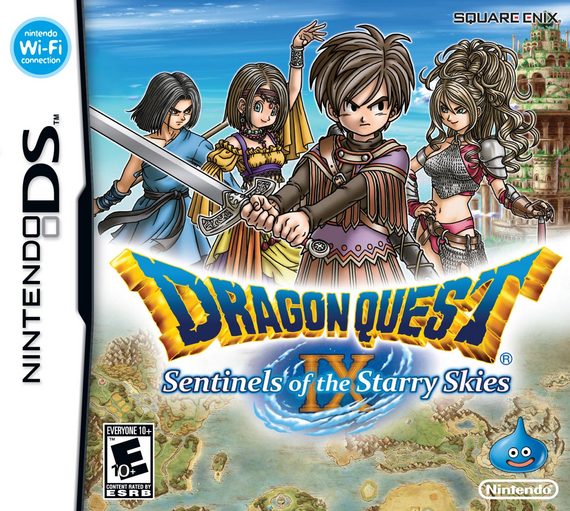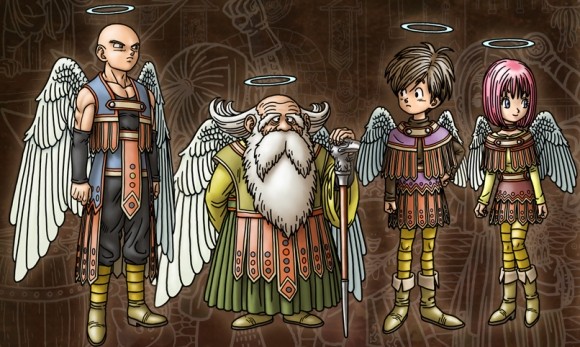 |
Dragon Quest IX is the newest title in the Dragon Quest series, and therefore the game born in Dragon Quest VIII’s ominous shadow. Surprisingly released exclusively for a portable system, the Nintendo DS. Which, I thought was an odd decision, but because it is such a good system I was never really worried. (Plus, the Dragon Quest games that have previously been released on it were very good.)
The game has a slightly different feel from the rest of the games, it takes the religious element to a new level, making the main character a Celestrian. (Which is essentially an angel) An interesting element to this game is that all of the playable characters are completely customizable. Including your main hero, which can either be male or female, with many different hair styles, skin colors, and body types.
The game starts with your Celestrian mentor showing you how to be the guardian of your own town. Then you are taken to a place called “the observatory” (which is the angel headquarters, a sort of mid-way to heaven), and told that you need to feed the world tree benevolence. You are essentially a ghost, and you go around helping people and collecting benevolence from them. (It might sound odd, but I thought it was a cool way to start the game.) After a short time, you return your benevolence to the world tree, Yggdrasil, but rather than helping the world, it has some cataclysmic effects throwing your character from the sky down to the Earth. The twist is, when your character lands, they’ve lost their wings, and can no longer go back to the observatory.
 |
Your character keeps some of their Celestrian powers, (like the ability to see dead people.) and you travel the world, going around saving town after town, trying to get back up to heaven. In this regard it has a similar feeling to many of the other Dragon Quest games, in as far as each of the towns have their own unique affliction.
One of the things that I liked best about this game was the job system. It was a lot like the system in Dragon Quest 3, and 7, where you get to choose the jobs of everyone of your party members, and you can change them as often as you like. In most ways, I think they perfected the system compared to the older models… but they left it with one thing that I consider a pretty major problem, which is, the benefit from leveling extra jobs on a single character is key, but for the most trivial reasons. For example, there are certain moves that you get on certain jobs that will benefit your character on every job greatly… but then you are leveling a single job 16 levels for a single move, and basically nothing else. Another problem, that isn’t the games fault, is that the leveling was addictive, and I wasted many hours doing nothing but that.
I felt this custom made character system worked well, it especially makes sense with the multi-player aspect of the game, but I think I prefer the designed character systems better. I also felt this game lacked in one other aspect because of the multi-player element (that I decided not to try out) and that was that the game was quest based, and almost every quest was completely optional, therefore the game had lots of things to do, but it required almost none of them. In this regard the game was actually quite small, in fact I would venture to say that the world map in this game was the second smallest of all the games.
Along with the quest system, it also had a vast alchemy system, where you can blend items to create really good weapons and armor… Although, it had a similar problem of simply not being necessary. So while these systems that I didn’t really care for were massive, it completely lacked some of the systems that were offered in the other Dragon Quest games that I generally anticipate. For example, a monster arena, and a casino. On the plus side of the item and alchemy systems was the fact that every piece of armor has its own skin. So you can make some really interesting looks for your characters depending on the armor you equip.
The construction of the battle system was hardly different than any of the other games, with very few exceptions, and it was good. There was one aspect where it fell short though, and that was that it was hardly ever a challenge… I think this was the easiest Dragon Quest game in the series. Some of the boss battles were still good, but ultimately unless you accidentally fought something you shouldn’t have, you will never have any trouble. Which is one of the things I like about most of the other Dragon Quest games, I think they are usually challenging, and this one was not. As a final statement on this subject, I will mention that the boss battle was a let down. Sorry Dragon Quest, you’ve done a lot better.
Finally, I’ll mention the overall story. Which I thought was good, but still nowhere near as good as the others. The Celestrial element is strong, but they don’t take it far enough. They have some good towns, and a really cool mode of transportation, which is a flying train called the starlight express, but it just isn’t as intricate as the other games.
The more I write this review, the more it makes it sound like I don’t like this game, but it isn’t the case. I think it is really good, but it might be one of the worst Dragon Quest games, which simply isn’t an insult. The art design by Akira Toriyama is as good as ever, if not better.. They even have some animated cartoon sequences, For example: an animated battle between Greygnarl an ancient dragon, and Barbarus, a resurrected black dragon. The animations are easily some of my favorite things that have come from the entire series… Not to mention the soundtrack of the game, which I thought was excellent.
Anyway, I’ll wrap up by saying that it is worth buying, and easy to play through… but don’t expect another Dragon Quest VIII. If for the overall score I was rating it against other Dragon Quest games, it would certainly get a lower score, but since I am just rating it in general, I’m giving it an 8 out of 10… It really is worth playing.
You can buy your copy of Dragon Quest IX on Amazon through this link!